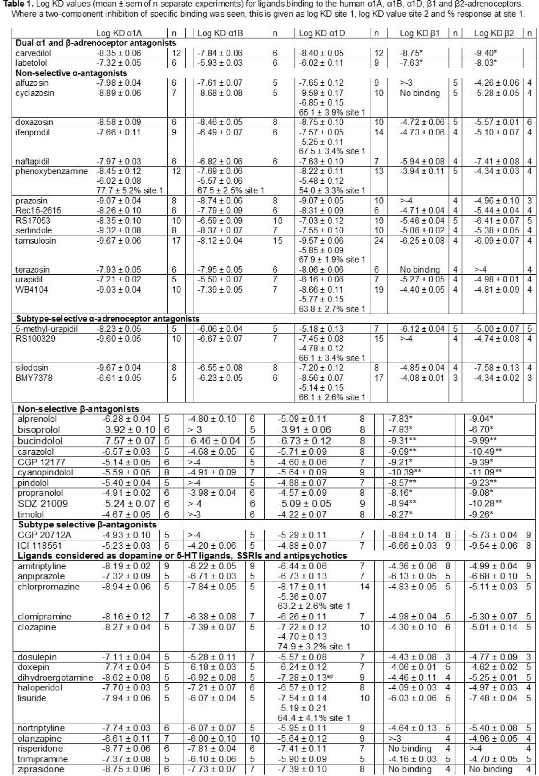Print version
Search Pub Med
| 026P London, UK Pharmacology 2017 |
A comparison of the selectivity of α and β-antagonists for the human α1A, α1B, α1D, β1 and β2-adrenoceptors.
Introduction: Both α1-adrenoceptor antagonists (e.g. doxazosin) and β1-adrenoceptor antagonists (e.g. bisoprolol) are used to manage hypertension (1,2). α1-antagonists are also widely used for benign prostatic hypertrophy (BPH). Clinically used β-blockers are not very selective for the β1 over the β2-adrenoceptor and thus are contraindicated in those who also have asthma (2). This study therefore compared the affinity and selectivity of ligands across the α1 and β-adrenoceptor subtypes (α1A, α1B, α1D, β1 and β2).
Methods: Stable CHO-K1 cell lines were generated expressing each of the human α1-adrenoceptors (3). 3H-prazosin (α1A, α1B and α1D) and 3H-CGP12177 (β1 and β2) whole cell binding assays were conducted (2hr incubation at 37°C (2)) with 134 ligands reported to interact with the human α1 and β-adrenoceptors.
Results: The affinity (KD values) for 3H-prazosin were: α1A 0.71nM, α1B 0.87nM, α1D 1.05nM (4) and 3H-CGP 12177 β1 0.42nM, β2 0.17nM (2). Carvedilol, known as a dual α1 and β-blocker, had high affinity for all 5 receptors, whereas labetolol, also considered a dual antagonist, had poor affinity for the α1B and α1D-adrenoceptors (see Table 1). Subtype selective ligands (i.e. those with selectivity of >100-fold) were identified (Table 1) in agreement with previous studies (e.g. 1, 2). Of the 134 ligands examined, no ligand was found that was α1B-selective. Whilst several drugs used for their neurological or psychiatric properties had high α1A-adrenoceptor affinity (also see (4)), none had high β1-affinity. Lisuride, generally considered to be a dopamine and 5-HT ligand, was the only other ligand with high β2-adrenoceptor affinity (see Table 1).
Conclusion: Whilst subtype selective ligands exist for the α1A, α1D, β1 and β2-adrenoceptors, no subtype selective ligand was found for the α1B-adrenoceptor. Carvedilol had high affinity for all 5 adrenoceptors. Whilst most ligands regarded as α-blockers or β-blockers were indeed highly selective for their respective subtype, silodosin and naftapidil (α1-antagonists) also had high affinity for the human β2-adrenoceptor, making these less attractive drugs for those with both benign prostatic hypertrophy and asthma. With the exception of lisuride, the other neurological or psychiatric ligands with high α1-affinity had very poor affinity for the β-adrenoceptors. The selectivity of these ligands for the human α2-adrenoceptors remains to be determined.
References:
(1) Docherty JR (2010) Cell. Mol. Life Sci. 67: 405-417.
(2) Baker JG (2005) Br J Pharmacol. 144: 317-322.
(3) Nojimoto FD et al., (2010) Neuropharmacology 59: 49-57
(4) Baker et al., abstract at this meeting


